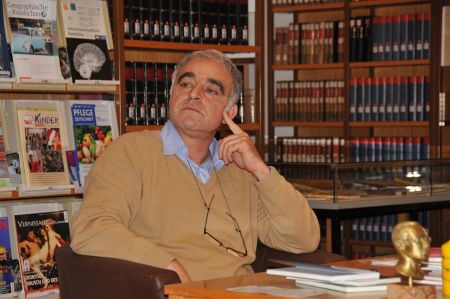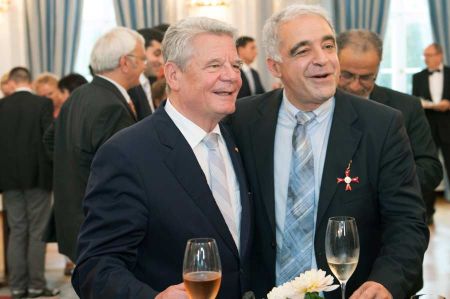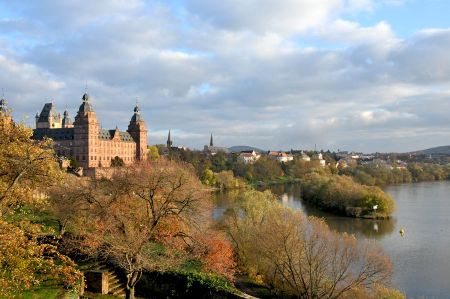Aschaffenburg - city tour an Johannisburg Castle
- Written by Portal Editor
The invitation from the Aschaffenburg Court Library and Amnesty International to read poems by the poet Nevfel Cumart, who lives in Bamberg, brought us to Schloss Johannisburg in Aschaffenburg.
Nevfel Cumart's poetry is synonymous with international understanding and tolerance towards other people, regardless of their origin or religion. In his verses, Cumart promotes understanding towards people from other cultures.
 In the evening, Nevfel Cumart, who himself was often a victim of prejudice due to his background, will recite biographical texts, sensitive love poems alongside socio-political poems. For years, Nevfel Cumart has also supported events aimed at getting the imprisoned Liu Xiaobo released. Tonight, he will support the joint event of the court library and Amnesty International by reading poetry from Xiaobo.
In the evening, Nevfel Cumart, who himself was often a victim of prejudice due to his background, will recite biographical texts, sensitive love poems alongside socio-political poems. For years, Nevfel Cumart has also supported events aimed at getting the imprisoned Liu Xiaobo released. Tonight, he will support the joint event of the court library and Amnesty International by reading poetry from Xiaobo.
In 2010, Chinese literary scholar Liu Xiaobo was awarded the Nobel Peace Prize for his long-standing non-violent commitment to human rights. However, he has been serving an eleven-year prison sentence since December 2009. Liu Xiaobo was arrested on June 23, 2009 for "inciting subversion of state power" and sentenced to 11 years in prison as one of the first signers of the so-called "Charter 08". He is a prisoner of conscience, being held only for because he exercised his right to freedom of expression.
Main bank and Pompejanum in Aschaffenburg
Since we had never been to Aschaffenburg before, we wanted to use the afternoon, which was announced with a few rays of sunshine, to explore the city for the first time. We quickly arrived in Aschaffenburg via the A3. We had entered the multi-storey car park at the Stadthalle as our destination, so that it was only a few minutes' walk to Johannisburg or to the old town and pedestrian zone of Aschaffenburg. In fact, the sky cleared up more and more, so that we postponed the originally planned visit to the State Gallery in the palace to a later date. The Staatsgallerie is known for the large collection of works by the painter Lucas Cranach the Elder, which is considered to be the most comprehensive in Europe.
So we first turned to the tree-lined banks of the Main, which was particularly attractive with its autumnal foliage colours and the deep sun. On the promenade in front of the castle, we first made our way to the Pompejanum, the replica of the Roman villa of Castor and Pollux (Casa dei Dioscuri) from Pompeii. King Ludwig I once commissioned the planning of the Pompejanum, which was then built between 1840 and 1848 according to plans by the architect Friedrich von Gärtner. In the 19th century there was a veritable boom in the enthusiasm for antiquity, so that with the construction of the Pompejanum, lovers of antiquity should be able to have a place to study Roman culture here.
On the way to the Pompejanum we also passed the so-called breakfast pavilion in the castle garden, which was built by Archbishop and Elector Friedrich Karl Joseph von Erthal, always accompanied by bushes and trees, small terraces and flower beds. It must be magnificent to see this path, which even now in late autumn with a wonderful view of the Main, was to be walked, in full bloom in early summer. The palace garden stretches from Johannisburg Palace to the Pompeianum and the St. Germain Terrace. Due to the lack of space around Johannisburg Palace - with a Capuchin monastery in the immediate vicinity - a representative palace garden in the Baroque style could never be laid out. This is how the somewhat crooked facilities on the banks of the Main were created with their narrow, curved paths, arcades and pergolas, walls and seating niches, footbridges and other architectural elements, including the herb garden on the stone steps. Interestingly, the focus of the planting is on Mediterranean plants such as figs and agaves, which make up the special Mediterranean flair of Aschaffenburg and have contributed to the nickname Bavarian Nice.
Floor mosaics in the Pompeianum
A little later we arrived at the almost windowless building of the Pompeianum. As was customary in Roman times, the lighting of the rooms was regulated by the inner courtyards, the so-called atrium. Unfortunately, we had to find out that the object of our desire is closed between October and March. So we could only look at the mighty building from the outside. In addition to the picture gallery in the castle, another reason to travel to Aschaffenburg again. The building's exterior color scheme, including Ionic columns, follows Tuscan traditions with a "Pompeii Red" base and corn yellow facade. The structure of the building is emphasized by the white parapets. The painted structure of the facade, which gives the impression of large blocks of stone, creates a lively overall picture of the otherwise windowless outer wall.
On the terrace we met an elderly couple who told us about the destruction of the Pompejanum during World War II and that it was only possible to reopen it in the 1960s after various phases of restoration. In addition to the artistic floor mosaics, there is said to be a large number of finds such as marble sculptures, small bronzes and glasses inside. The exhibition will also contain objects from Roman times that illustrate life in the family. Only last year we had a thorough look at the Roman villa in Ahrweiler, where we were particularly fascinated by the really impressive hypocaust systems of the heating systems, which can be studied particularly well here.
In the meantime, hunger had set in and so the decision to visit the old town first was quickly put into practice. On the way there we passed a Turkish restaurant that tempted us to stop for lunch. And ... we were not disappointed, quite the opposite.
Aschaffenburg's beginnings probably date back to the 5th century, when the Alemanni settled at a ford across the Main and on the adjacent hill. An old trade route crossed the Main here. Finds from excavations in the upper town show that there was a larger settlement here early on. The Franks followed the Alemanni.
In 869 the East Franconian King Ludwig III, the younger, married Luitgard, the daughter of Duke Luidolf of Saxony in Aschaffenburg. In 957, Duke Liudolf von Schwaben founded a monastery for the later-born sons of the nobility, the monastery of St. Peter, later St. Peter and Alexander. In 982 the city came as a gift to the archbishopric and electorate of Mainz and from then on it was always the second residence of the people of Mainz. Archbishop Willigis built the first wooden bridge over the Main in 987. In the 12th century, the settlement received new fortifications from Archbishop Adalbert I of Saarbrücken, which was expanded over the following centuries. Belonging to Mainz has had a lasting impact on Aschaffenburg, which is not only evident in the coloration of the language.
The old town attracts with the Stiftsbasilika and Webergasse
Through the Webergasse and the Stiftsstrasse, which could have some beautiful half-timbered facades, we reached the monastery basilica of St. Peter and St. Alexander, the oldest church in Aschaffenburg. It was also initiated by Duke Liudolf von Schwaben (son of Emperor Otto I) and his wife Ida von Schwaben (daughter of Duke Hermann I von Schwaben) probably between 947 and 957, since Liudolf lost the duchy in agreed this year. Later, the couple's son, Otto, Duke of Swabia, founded the collegiate monastery of St. Peter and St. Alexander with the monastery school. The construction of the collegiate church began in 975.
Behind the monastery well, which was only rebuilt in 1998, you climb the stairs to the church to find a unique ensemble: the late Romanesque monastery church with its famous cloister forms a unit with the medieval buildings of the monastery chapter. The church is open and so we can take a good look at some of the numerous art treasures and jewels such as the grave monument for Archbishop and Elector Albrecht of Brandenburg, a crucifix from the 10th century and Grünewald's "Lamentation for Christ".
Through Herstallstrasse, which is probably the main part of the pedestrian zone, we reach the Herstallturm, which was one of two original towers that were preserved as part of the city fortifications. The tower bears the year 1545 and the coat of arms of Cardinal Albrecht von Brandenburg.
Today, the Herstall Tower "guards" the beginning of the pedestrian zone, which stretches from Steingasse, Badergasse and Roßmarkt to Sandgasse. We cross these shopping zones, which surprise us in relation to the size of the city. We hadn't expected so much shop and retail space in the district.
Pedestrian zone at the Stiftsbrunnen and Herstallturm
In the meantime, the time that was available to us before the evening reading in the Johannisburg has also expired, so it is time to return to the castle, which is now considered the symbol of the Spessart metropolis Aschaffenburg. The magnificent building of the German late Renaissance was built between 1605 and 1614, the builder was Archbishop and Elector Johann Schweikard von Kronberg, master builder the Strasbourg architect Georg Ridinger. When looking at the huge building complex from the outside and knowing about the background of the builders, the building project of Tebartz-van Elst, the Bishop of Limburg, is put into perspective at least a little.
In addition to the collection of paintings already mentioned, the castle also houses the world's largest collection of cork architectural models, but all of that for a later visit in another report. Via the inner courtyard of the castle we finally reach the state court library of Aschaffenburg, which also administers the Aschaffenburg Abbey Library with approx. 22,000 volumes, 86 manuscripts and 586 incunabula. A worthy setting for Nevfel Cumart's reading, which is about to begin, is the impression upon entering the library.
 Nevfel Cumart enters the room a little later. He doesn't have a rigid concept in his pocket, as he expressly emphasizes. Perhaps that is why his lectures are so unique:
Nevfel Cumart enters the room a little later. He doesn't have a rigid concept in his pocket, as he expressly emphasizes. Perhaps that is why his lectures are so unique:
In between
my wife greek
my best man american
my mother is turkish
my friend Yemeni
my goddaughter german
my neighbour algerian
my professor austrian
my doctor iraqi
and somewhere
in between
I
on this speck of dust
called earth
Nevfel Cumart from: Sleepy the Stars
Please read as well:
Serbia in transition – some approaches for understanding
Stopover at Drübeck monastery - with a recommendable café
-
 City Hike Old Town Aschaffenburg
City Hike Old Town Aschaffenburg
City Hike Old Town Aschaffenburg
City Hike Old Town Aschaffenburg
-
 City Hike Old Town Aschaffenburg
City Hike Old Town Aschaffenburg
City Hike Old Town Aschaffenburg
City Hike Old Town Aschaffenburg
-
 City Hike Old Town Aschaffenburg
City Hike Old Town Aschaffenburg
City Hike Old Town Aschaffenburg
City Hike Old Town Aschaffenburg
-
 City Hike Old Town Aschaffenburg
City Hike Old Town Aschaffenburg
City Hike Old Town Aschaffenburg
City Hike Old Town Aschaffenburg
-
 City Hike Old Town Aschaffenburg
City Hike Old Town Aschaffenburg
City Hike Old Town Aschaffenburg
City Hike Old Town Aschaffenburg
-
 City Hike Old Town Aschaffenburg
City Hike Old Town Aschaffenburg
City Hike Old Town Aschaffenburg
City Hike Old Town Aschaffenburg
-
 City Hike Old Town Aschaffenburg
City Hike Old Town Aschaffenburg
City Hike Old Town Aschaffenburg
City Hike Old Town Aschaffenburg
-
 City Hike Old Town Aschaffenburg
City Hike Old Town Aschaffenburg
City Hike Old Town Aschaffenburg
City Hike Old Town Aschaffenburg
-
 City Hike Old Town Aschaffenburg
City Hike Old Town Aschaffenburg
City Hike Old Town Aschaffenburg
City Hike Old Town Aschaffenburg
-
 City Hike Old Town Aschaffenburg
City Hike Old Town Aschaffenburg
City Hike Old Town Aschaffenburg
City Hike Old Town Aschaffenburg
-
 City Hike Old Town Aschaffenburg
City Hike Old Town Aschaffenburg
City Hike Old Town Aschaffenburg
City Hike Old Town Aschaffenburg
-
 City Hike Old Town Aschaffenburg
City Hike Old Town Aschaffenburg
City Hike Old Town Aschaffenburg
City Hike Old Town Aschaffenburg
-
 City Hike Old Town Aschaffenburg
City Hike Old Town Aschaffenburg
City Hike Old Town Aschaffenburg
City Hike Old Town Aschaffenburg
-
 City Hike Old Town Aschaffenburg
City Hike Old Town Aschaffenburg
City Hike Old Town Aschaffenburg
City Hike Old Town Aschaffenburg
-
 City Hike Old Town Aschaffenburg
City Hike Old Town Aschaffenburg
City Hike Old Town Aschaffenburg
City Hike Old Town Aschaffenburg
https://www.alaturka.info/en/germany/bavaria/6040-aschaffenburg-city-tour-an-johannisburg-castle#sigProId596e980d63

